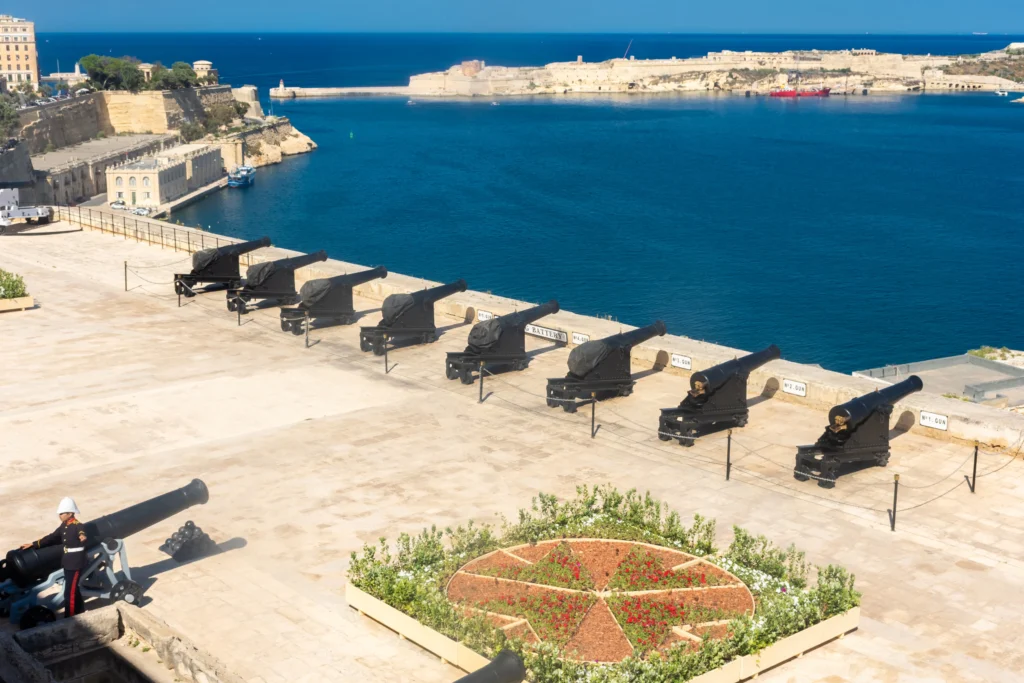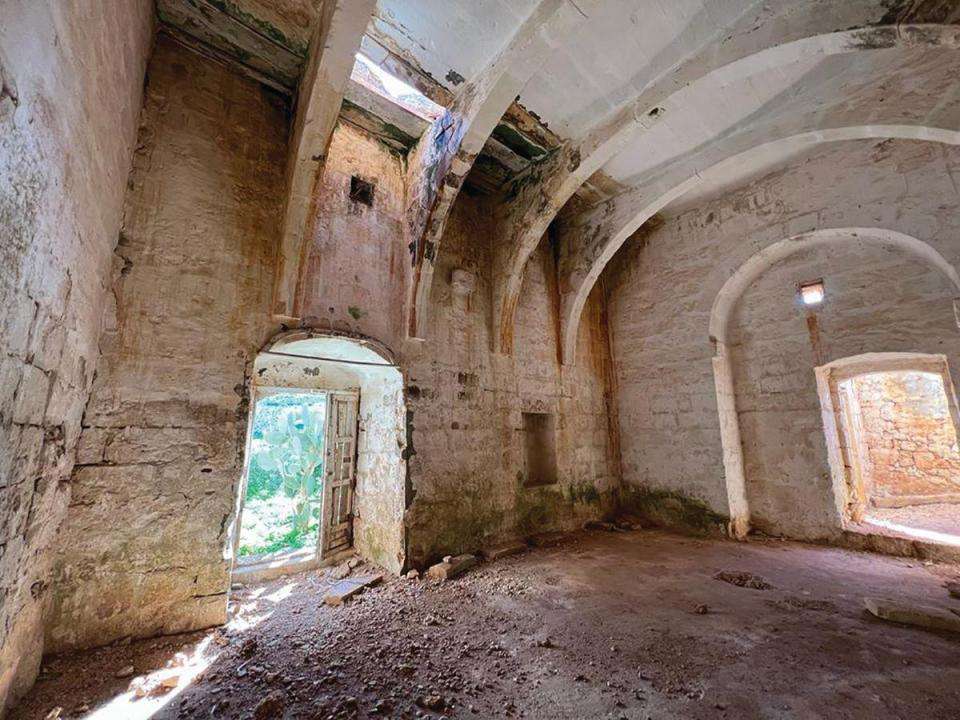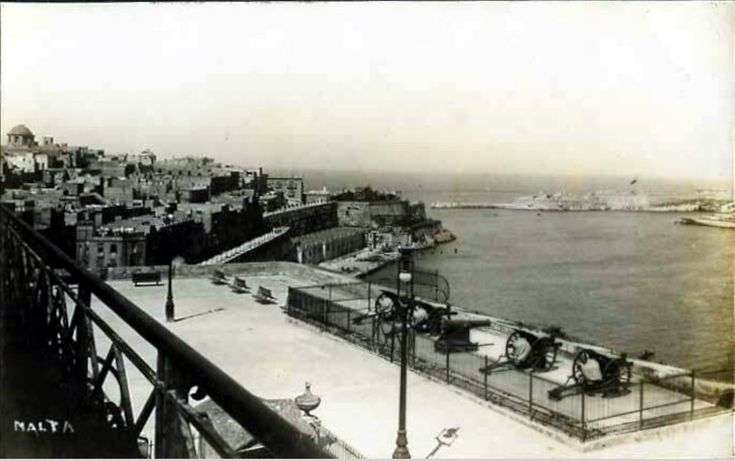Table of Contents
ToggleA Day at the Barrakka
Valletta’s Gardens of History, Views, and Calm
If Valletta had a single place that could capture its soul, it would be the Barrakka. Perched high above the Grand Harbour, the Barrakka is not one spot but a pair of gardens—Upper and Lower—linked by the modern Barrakka Lift. Together, they offer a blend of history, beauty, and tranquillity that mirrors Malta’s capital itself. Spend a few hours here, and you’ll experience the essence of Valletta: a city where the grandeur of the Knights of St. John, the scars of wars, and the pleasures of everyday Mediterranean life all collide.
Upper Barrakka Gardens
Stepping off the lift, you emerge into the Upper Barrakka Gardens, Valletta’s most visited green space. Originally created in 1661 for the Italian knights of the Order of St. John, the gardens were once private cloisters of contemplation. Today, they belong to the people, and to the world. Walking through its arched colonnades and shaded paths, you’re greeted by sweeping panoramas of the Grand Harbour, the Three Cities of Senglea, Cospicua, and Vittoriosa, and the endless rhythm of ships gliding in and out.
The terraces are dotted with statues and memorials: Sir Winston Churchill gazing sternly into the distance, Sir Thomas Maitland immortalised in stone, Gerald Strickland honoured for his role in Maltese politics. Perhaps the most charming is the bronze group Les Gavroches by Antonio Sciortino—a tribute to Parisian street children that feels perfectly at home in a garden where everyday life unfolds.
Time your visit carefully, and you can witness one of Valletta’s most thrilling spectacles: the Saluting Battery. Each day at noon and 4 p.m., cannons are fired across the harbour in a tradition that dates back centuries. The sound reverberates through the bastions, startling tourists and delighting locals. It’s a reminder that this city, though serene today, once bristled with military might.
Location

Lower Barrakka Gardens
While the Upper Barrakka dazzles with grandeur, the Lower Barrakka Gardens—a short walk away—offer something different: peace. Tucked further down the bastions, these gardens are less crowded and feel almost secretive. Palm trees sway in the breeze, flowers bloom quietly, and benches invite you to pause. At the centre stands the neoclassical Monument to Sir Alexander Ball, a British admiral who played a decisive role in Malta’s struggles against Napoleon. With its Doric columns, the monument resembles a miniature Greek temple, lending the garden a timeless, contemplative air.
Here, the bustle of Valletta seems far away. You might hear the faint hum of a ferry in the harbour, the murmur of friends chatting over coffee at the nearby kiosk, or the soft splash of a fountain. Many travellers who find the Upper Gardens too busy retreat here for respite. It is the perfect place to sit with a book, sip an espresso, or simply let your gaze drift across the water.
Location

Rising into Valletta
Many visitors begin their Barrakka journey at the base of the city, where ships dock at the Grand Harbour. Here stands the Barrakka Lift, a sleek, modern structure made of steel and aluminium mesh. At 58 metres high, it whisks passengers from the water’s edge to the heart of Valletta in just 23 seconds. The lift feels futuristic, yet it is rooted in history—its predecessor, built in 1905, once served as a vital link before being dismantled in the 1980s. Its rebirth in 2012 symbolises Malta’s ability to honour its past while embracing progress. As the lift rises, the harbour stretches wider below, the bastions grow taller, and anticipation builds for the views awaiting at the top.

The Barrakka Experience
What makes the Barrakka so compelling is the contrast between its two halves. The Upper Gardens are vibrant, social, and photogenic—where tourists snap panoramas and families gather for the cannon show. The Lower Gardens, by contrast, are serene, understated, and ideal for reflection. Linking them is the lift, which itself is part of the story, marrying Valletta’s historic walls with modern design. Together, they encapsulate the dual nature of the city: outward-looking and lively, yet also deeply rooted and reflective.

Practical Tips for Visiting
To make the most of your visit, plan to arrive in the morning, when the gardens are quiet and the harbour glows in soft light. If you can, linger until noon to watch the Saluting Battery. Entrance to the gardens is free, but a small fare (around €1) is charged for the Barrakka Lift. The Lower Gardens can be reached on foot via Valletta’s winding streets or by descending from the Upper Gardens. Comfortable shoes are recommended—the city’s slopes are part of its charm, but they can be demanding.
Bring a camera for the sweeping vistas, but also take time to put it away. The magic of the Barrakka lies not only in what you see but in how it makes you feel: suspended between sea and sky, past and present.
Why the Barrakka Matters
A day at the Barrakka is not just about gardens—it’s about experiencing Valletta’s spirit from above and below. The Upper Barrakka offers drama and spectacle, the Lower Barrakka offers calm and reflection, and the Lift stitches them together in a journey that is as symbolic as it is practical. Next time you find yourself in Valletta, take that ride, wander those paths, and let the views wash over you. The Barrakka will leave you with a memory as enduring as the bastions themselves.

A day at the Barrakka is not just about gardens—it’s about experiencing Valletta’s spirit from above and below. The Upper Barrakka offers drama and spectacle, the Lower Barrakka offers calm and reflection, and the Lift stitches them together in a journey that is as symbolic as it is practical. Next time you find yourself in Valletta, take that ride, wander those paths, and let the views wash over you. The Barrakka will leave you with a memory as enduring as the bastions themselves.



